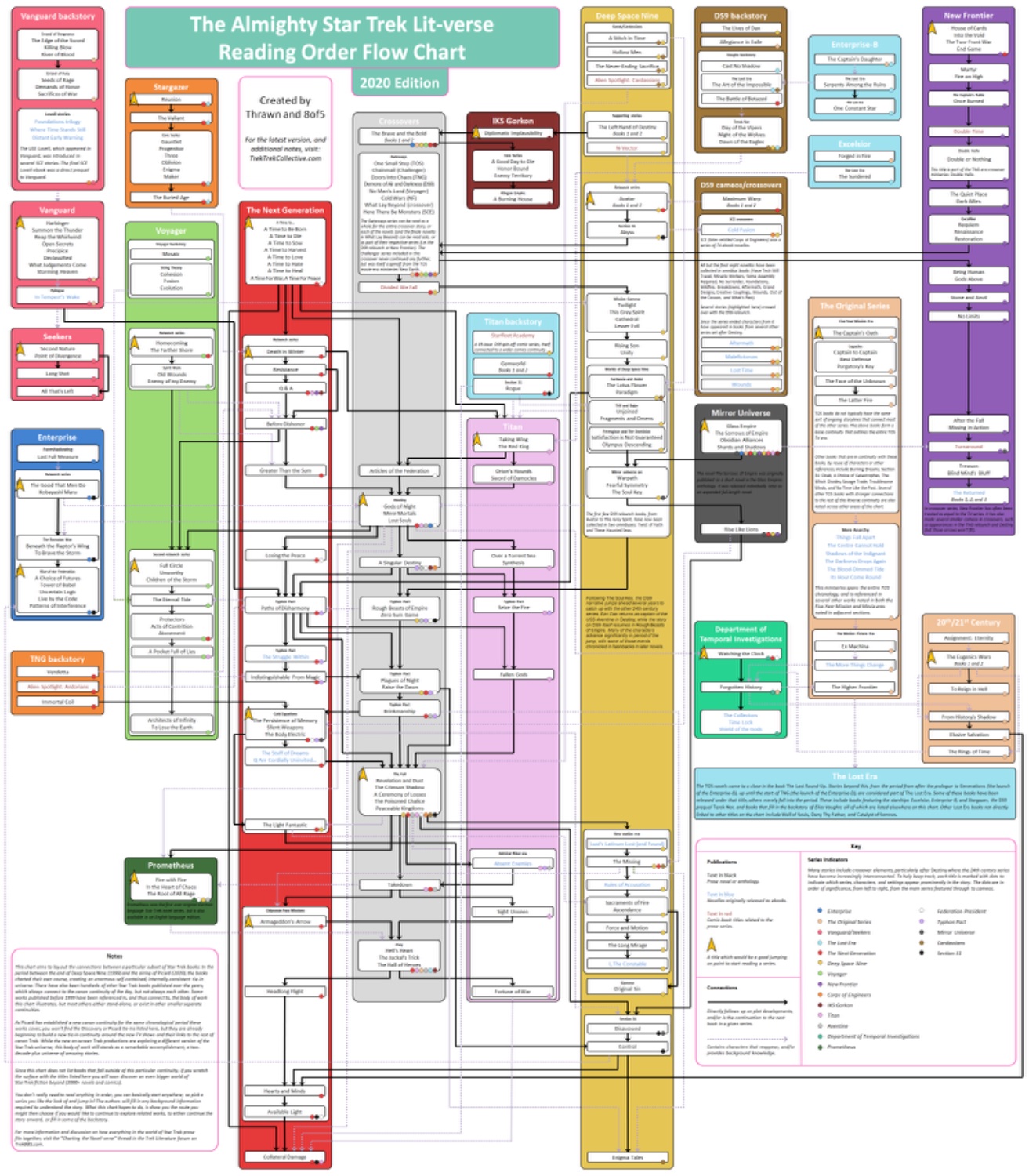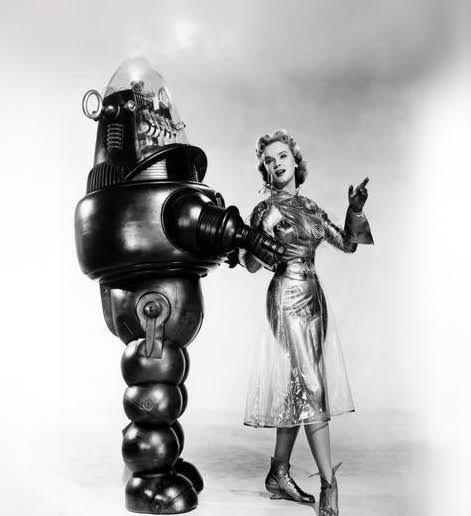I find this [Relaunch Litverse reading order flowchart ] (https://www.thetrekcollective.com/p/trek-lit-reading-order.html?m=1 )super useful. It hasn’t been updated to include the final Coda trilogy that crosscuts pretty much everything.

I find this [Relaunch Litverse reading order flowchart ] (https://www.thetrekcollective.com/p/trek-lit-reading-order.html?m=1 )super useful. It hasn’t been updated to include the final Coda trilogy that crosscuts pretty much everything.

The Relaunch Litverse continued a bit after the new shows started to wrap up the political storyline and some of the other sequences. A trilogy called Coda concluded that timeline. Most fans have mixed feelings about it.
Una McCormack has one more book ‘The Missing’ which is the Pulaski one I mentioned.
The IP holder is the owner of the intellectual property and franchise rights. This shifted over time with the Viacom breakup then more recent. For a while Paramount had the movie rights and CBS the television rights. Simon & Schuster basically licenses from them to contract tie-in writers for hire. The IP rights from all the books stay with the IP holder. What the writers can do is limited by what the IP holder will allow the licensee.
Glad you’re enjoying reading. I also found television was impossible when our kids were little, and what I did watch was their preschool television with them.
Couple of points, then suggestions.
First, the Relaunch Treklit novelverse is a separate continuity from the new television series. I personally prefer a lot of the choices of major political arcs in the Relaunch timeline better than the new shows. Interestingly, the last season of Picard started to bring in some parallels from the books, despite being a very different future for Picard himself.
The Relaunch universe basically branched to be an alternate universe somewhere in the TNG ‘Time to’ book sequence. So you’re quite invested at this point, and I would suggest carrying on if you enjoy it.
Second, where you go next in the Relaunch universe really depends on the kinds of stories you like.
— Una McCormack has a few more Cardassia focused books. If you haven’t read them all yet, I’d suggest those given your preference for her book in the Fall. The book with Dr Pulaski is great and important but should be read after the Bashir S31 sequence if you’re going to do that.
— Mack’s Bashir S31 sequence is dark but very well done. Depends on whether a singular hero against the skulduggery machine is your thing.
— the Titan books are mainly about exploration, but as Riker is an Admiral, they cross back and forth through the political storyline.
— After the Fall, Dayton Ward took on the TNG exploration sequence in the Odesseyus Reach. Mostly classic exploration but the outcomes of the political stuff eventually catches up with Picard. David Mack wrote the book ‘Collateral Damage’ where Picard returns to deal with the fallout of The Fall. It’s just about the end of the Relaunch books.
— I gave up on the DS9 books around where you are. George writes as if he is writing backstory bibles rather than a narrative much of the time and he seemed to be one of the principals for that part of the universe.
— the Voyager books advanced much more slowly through the timeline. I found the Christie Golden books exasperating (mainly due to the constraints out in her by the IP holder). When Kirsten Beyer took over and started the Full Circle sequence she was given freedom to fix many issues. It’s a great set of return to the Delta Quadrant books. Some recommend just starting with ‘Full Circle’ and going forward from there. Beyer takes about the first half of that book catching you up and moving things forward.
In terms of the new shows, you could watch Lower Decks without spoiling anything else as it’s set in the early to mid 2380s. It’s also animated with 22 minute episodes so more likely manageable for your reality.
Before you star Picard the television show, I would suggest two things. 1) watch the Kelvin Universe movie Star Trek 2009 as it sets up a major event in the Prime Universe that really is the major fork between the Prime television and Relaunch Litverse. 2) Read Una McCormack’s excellent prequel book ‘The Last Best Hope’ that sets up the Picard television show. There are a number of new books out that are based on the new television shows. You will want to wait to read most those until after you have seen the relevant seasons of the shows.
Hope this helps.
The ‘colour-blind’ director thing turns out to have been somewhat of a fan myth that took on a life of its own. Or at least a major exaggeration. It’s not a fact and shouldn’t be repeated as such.
Sutherland, the director, was colourblind, however the person making the colour choice was Irv Kaplan.
According to The Official Guide to TAS (by Harvey and Schepis), based on reports of colleagues, Kaplan was “in charge of ink and paint, colouring the various props and characters, and he would do it by himself in his office…..It was all Irv Kaplan’s call. He wasn’t listening to anyone else when he picked colors, or anything.”
Irv liked the hot pinks, purples, lime greens etc that were very much in vogue at the time. Other Saturday contemporary morning cartoons (such as Josie and the Pussycats) were using similar palettes.
I have to stan MGM’s original Robby the Robot who made his first movie appearance in Forbidden Planet (1956).
But as much as Roddenberry was inspired by Forbidden Planet, Star Trek didn’t get an mobile AI crew member until TNG.

I put out a call for viable in-universe opponents to Moopsy on Mastodon.
My own list included:
Mellanoid slimeworms (i.e., Murf)
Armus
Species 8472
Q and other transcendent beings.
Others have pointed out that Changelings don’t have bones.
Some have suggested that a Changeling might keep a Moopsy as a pet. A predator that liquified solids could have a certain morbid appeal one might imagine.
Can’t let an opportunity go past to remind everyone that Larry Niven doesn’t seem to have complained that the Kzinti ship in TAS ‘The Slaver Weapon’ was mauvish-pink.

Boimler looks unhappy and stressed in every single image where he appears.
I wonder it that will be an A, B, or C plot element?
He really seems to have reset to his most fragile with the promotion. Hope this gets resolved by end of season.
@GoodAaron@startrek.website ’s one was the one I’d been most hoping for from the time the Very Short Treks were announced, and so far it’s the only one that hasn’t disappointed me.
I have the sense that they are as a whole targeting at a very narrow audience demographic, principally of Americans who were young adults and teens in the late 90s.
I never quite got how ‘drinking poop’ preschool to 9 year-old boy humour took mainstream hold in Austin Powers (which I otherwise loved), but acknowledge it as having been a thing. I can even recognize intellectually that its in a long tradition of low humour that goes back to the ‘great fart’ of ‘The Miller’s Tale’ in Chaucer.
What I don’t get is why the folks who didn’t age out of this kind of humour seem to thing that there’s currently a huge untapped audience that’s just looking for the kind of stuff we got in the earlier VSTs.
I can only speak for those I’ve read - Iane Duane’s ‘Doctor’s Orders’ is a fine, easy read.
I loved Beyer’s ‘Children of the Storm’ but it’s in the midst of her Voyager Full Circle cycle. So it depends on whether you mind dropping in the middle of a long running series.
The Voyager String Theory trilogy is earlier in the timeline. Uneven but interesting.
Just bookmark the Simon & Schuster Star Trek ebook deals page. A new list should be posted the day after this promotion ends.
There’s also the option to signup for emails from the publisher for promotions (valid in the US only) that include other books and franchises.
I’ll continue to post the Star Trek deal links periodically here too.
Disquieting nonetheless.
Lower Decks has successfully brought in new viewers to the franchise and led them into other shows. It’s also held viewers who just signed up for Picard.
As the most successful digital animated comedy on Paramount Plus in 2022, and with animated comedies being a key attractor for younger viewers, it seems like the show shouldn’t be at risk.
It’s not like they can get another animated Trek comedy off the ground in less than two full calendar years. More Lower Decks is successfully threading the needle between attracting new young viewers and pleasing older core fans. The Very Short Trek experiment was largely a failure with all but narrow slice of American fans in a narrow demographic. It showed that comforting those fans will alienate those they already have.